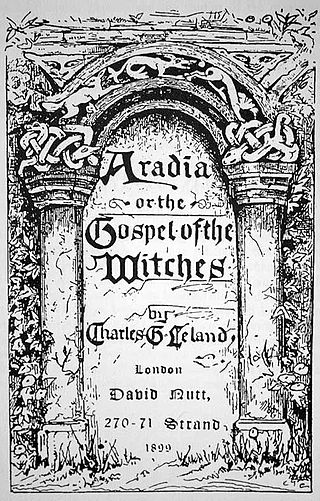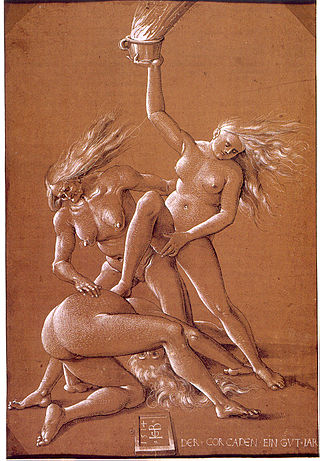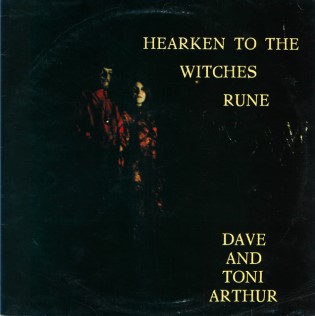
Wicca, also known as "The Craft", is a modern pagan, syncretic, earth-centered religion. Considered a new religious movement by scholars of religion, the path evolved from Western esotericism, developed in England during the first half of the 20th century, and was introduced to the public in 1954 by Gerald Gardner, a retired British civil servant. Wicca draws upon ancient pagan and 20th-century hermetic motifs for theological and ritual purposes. Doreen Valiente joined Gardner in the 1950s, further building Wicca's liturgical tradition of beliefs, principles, and practices, disseminated through published books as well as secret written and oral teachings passed along to initiates.
Aradia is one of the principal figures in the American folklorist Charles Godfrey Leland's 1899 work Aradia, or the Gospel of the Witches, which he believed to be a genuine religious text used by a group of pagan witches in Tuscany, a claim that has subsequently been disputed by other folklorists and historians. In Leland's Gospel, Aradia is portrayed as a messiah who was sent to Earth in order to teach the oppressed peasants how to perform witchcraft to use against the Roman Catholic Church and the upper classes.
Stregheria is a neo-pagan tradition similar to Wicca, with Italian and Italian American origins. While most practitioners consider Stregheria to be a distinct tradition from Wicca, some academics consider it to be a form of Wicca or an offshoot. Both have similar beliefs and practices. For example, Stregheria honors a pantheon centered on a Moon Goddess and a Horned God, similar to Wiccan views of divinity.

In folklore, a silver bullet is often one of the few weapons that are effective against a werewolf, vampire, witch, or other supernatural beings. The term silver bullet is also a metaphor for a simple, seemingly magical, solution to a difficult problem: for example, penicillin circa 1930 was a "silver bullet" that allowed doctors to treat and successfully cure many bacterial infections.

In folklore, a crone is an old woman who may be characterized as disagreeable, malicious, or sinister in manner, often with magical or supernatural associations that can make her either helpful or obstructive. The Crone is also an archetypal figure or a Wise Woman. As a character type, the crone shares characteristics with the hag. The word became further specialized as the third aspect of the Triple Goddess popularized by Robert Graves and subsequently in some forms of neopaganism. In Wicca, the crone symbolizes the Dark Goddess, the dark side of the moon, the end of a cycle; together with the Mother Crone, the Light Goddess and the Crone Maiden, Day Goddess, she represents part of the circle of life. The Handsome Warlock or Beautiful Witch, good or bad may change a Crone or Hag to normal looks, appearance if so desired.

Osculum infame is a witch's supposed ritual greeting upon meeting with the Devil. The name means the 'shameful kiss' or 'kiss of shame', since it involved kissing the devil's anus, his "other" mouth. According to folklore, it was this kiss that allowed the Devil to seduce women.

Francis Hindes Groome was a writer and foremost commentator of his time on the Romani people, their language, life, history, customs, beliefs, and lore.

Charles Godfrey Leland was an American humorist and folklorist, born in Philadelphia, Pennsylvania. He was educated at Princeton University and in Europe.
A witch's ladder is a practice, in folk magic or witchcraft, that is made from knotted cord or hair, that normally constitutes a spell. Charms are knotted or braided with specific magical intention into the cords. The number of knots and nature of charms varies with the intended effect.

Aradia, or the Gospel of the Witches is a book composed by the American folklorist Charles Godfrey Leland that was published in 1899. It contains what he believed was the religious text of a group of pagan witches in Tuscany, Italy that documented their beliefs and rituals. Historians and folklorists have disputed the existence of such a group. During the 20th century, the book was influential in the development of the contemporary Pagan religion of Wicca.

The Church and School of Wicca was founded by Gavin Frost and Yvonne Frost in 1968. It was the first federally recognized Church of the religion known as Wicca in the United States. It is known for its correspondence courses on the Frosts' unique interpretation of Wicca. The Church and School are located in Beckley, West Virginia.
Green Egg is a Neopagan magazine published by the Church of All Worlds intermittently since 1968. The Encyclopedia of American Religions described it as a significant periodical.

The King of England and his Three Sons is a Romani fairy tale collected by Joseph Jacobs in More English Fairy Tales. He listed as his source Francis Hindes Groome's In Gypsy Tents, where the informant was John Roberts, a Welsh Roma. Groome published the tale as An Old King and his three Sons in England.
The Little Bull-Calf is an English Romani fairy tale collected by Joseph Jacobs in More English Fairy Tales.

European witchcraft is a multifaceted historical and cultural phenomenon that unfolded over centuries, leaving a mark on the continent's social, religious, and legal landscapes. The roots of European witchcraft trace back to classical antiquity when concepts of magic and religion were closely related, and society closely integrated magic and supernatural beliefs. Ancient Rome, then a pagan society, had laws against harmful magic. In the Middle Ages, accusations of heresy and devil worship grew more prevalent. By the early modern period, major witch hunts began to take place, partly fueled by religious tensions, societal anxieties, and economic upheaval. Witches were often viewed as dangerous sorceresses or sorcerers in a pact with the Devil, capable of causing harm through black magic. A feminist interpretation of the witch trials is that misogynist views of women led to the association of women and malevolent witchcraft.

The Museum of Witchcraft and Magic, formerly known as the Museum of Witchcraft, is a museum dedicated to European witchcraft and magic located in the village of Boscastle in Cornwall, south-west England. It houses exhibits devoted to folk magic, ceremonial magic, Freemasonry, and Wicca, with its collection of such objects having been described as the largest in the world.
Rosemary Ellen Guiley was an American writer on topics related to spirituality, the occult, and the paranormal. She was also a radio show host, a certified hypnotist, a board director of the "National Museum of Mysteries and Research" and the "Foundation for Research into Extraterrestrial Encounters", and a "Lifetime Achievement Award" winner from the Upper Peninsula Paranormal Research Society, Michigan. She has written more than 49 books, including ten encyclopedias.
Jessie Wicker Bell or Lady Sheba was an American writer on Celtic Wicca and founder of the American Order of the Brotherhood of the Wicca with the aim to unite all practitioners of Wicca.

"The Creation of the Violin" is a Transylvanian/South Hungarian Roma (gypsy) fairy tale.

Hearken to the Witches Rune is a studio album by the English folk music duo Dave and Toni Arthur, recorded in 1970 and released by Trailer Records. It features English folk music with a focus on uncanny and magical elements. Ahead of making the album, the Arthurs held discussions with the Wiccan leader Alex Sanders and were invited to Wiccan coven meetings. The title comes from Doreen Valiente's poem "The Witches' Chant". The album has not been rereleased and has developed a cult following.












